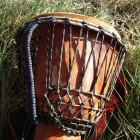Last spring, after a couple of years off from playing West African music, the local dance teacher reached out to see if we could start some regular practice on traditional dundun rhythms.
Yes!
So we began, with a few others trying out until we settled on a core study group of four to six players. The dance teacher has learned some of the rhythms before and knows what she likes from dance classes; otherwise it mainly falls to me to share parts from my store of resources and experience.
 As with drum students everywhere, the written notation works for some and not for others. I bring notes to rely on and support my porous memory, so at least I can model all the parts accurately for others to learn. For those students who relate to it, the notation serves both to follow along closely when learning beat by beat, and to reference visually the single or multiple bars of a pattern.
As with drum students everywhere, the written notation works for some and not for others. I bring notes to rely on and support my porous memory, so at least I can model all the parts accurately for others to learn. For those students who relate to it, the notation serves both to follow along closely when learning beat by beat, and to reference visually the single or multiple bars of a pattern.
We usually have three separate dunun players (traditional style with bells), and once they get rolling, I practice djembe parts, traditional solos, breaks, and improvisation. With the following notation you can share what we’ve been grooving with. All the rhythms have traditional sources, but at this stage they are mixed and mingled, adapted to our circumstance and taste.
Pro Tip: Lately there’s so much good stuff to choose from (beyond the projects of Bolokondo and Dunungbe), so for the next rhythm to practice, we pick from a hat.
For written notation and audio tracks for your solo and group practice, see the Roots Jam collection (4 volumes to choose from) at Amazon.com or the DjembeRhythms.com order page.

